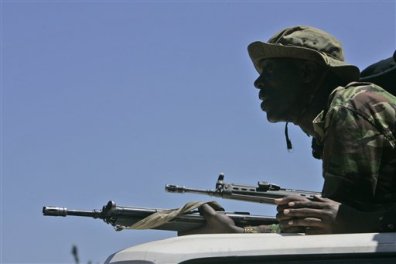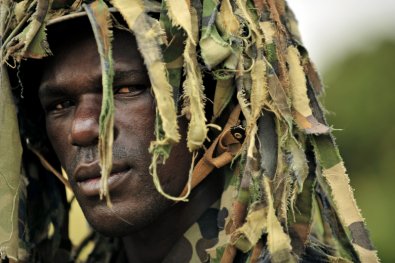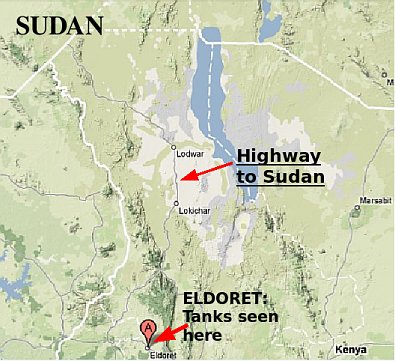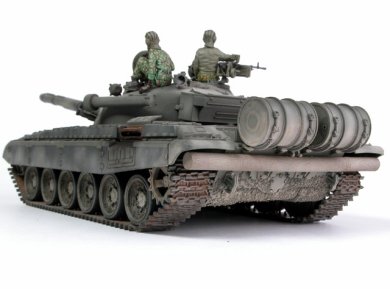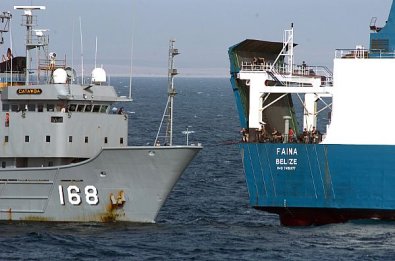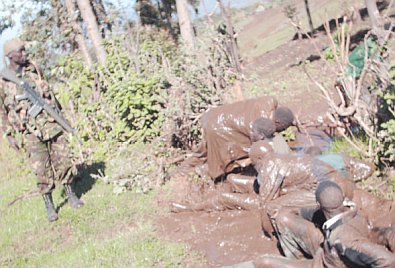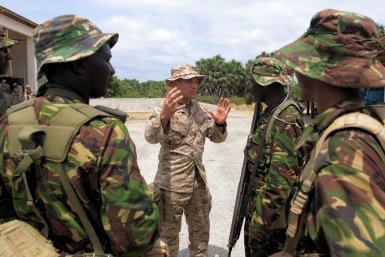A report on human rights abuses in Mt Elgon reveals that area Member of Parliament, Fred Kapondi, won the seat after rivals were threatened with death by the Sabaot Land Defence Force. However, Mr Kapondi’s electoral tactics were not unique. The report adds that in the past 15 years, all legislators from the constituency have used armed militias to get to parliament.

Mt Elgon. Its slopes have been witness to horrific torture and killings. Picture by BMS-Travellers
The report, released this week by Human Rights Watch graphically describes acts of torture committed by the Sabaot Land Defence Force (SLDF) and Kenya’s security forces. In a sense, the people of Mt Elgon are under attack from the two protagonists.
Virtually all males over the age of 10 have been targetted, either for recruitment by the SLDF or for interrogation by the Kenya Army and Police. “Mt. Elgon is a mountain of women, all the men have gone,” lamented a widow who found her husband’s body at the Webuye mortuary, two weeks after he was abducted by the army.
Here are excerpts of the report by Human Rights watch, with damning evidence against Mr Kapondi:
Wilberforce Kisiero, the MP for the former ruling party KANU between 1982 and 1997 was widely cited as one of the proponents of violence in the district. He was implicated in the state sponsored clashes of 1991-93, and named in the Akiwumi report, the parliamentary investigation into the political violence of the 1990s.
John Serut, the MP from 2002 to 2007, and Fred Kapondi, the current MP elected in 2007, were accused by local residents and human rights organizations of working to recruit, train, and finance militia who intimidated opponents in the 1997, 2002, and 2007 elections.
Having initially worked together (Kapondi was formerly KANU party chairman in the district), by the time of the 2007 General Elections, Serut and Kapondi had fallen out, according to residents. After that, the SLDF began to target supporters of Serut, including Serut himself. An area chief explained that because Serut supported the Chepyuk III settlement scheme against the wishes of most within the SLDF, Kapondi got a chance to run the boys, and this gave him the political powerbase he needed to win the election.
A neighbor of Kapondi told how he was repeatedly harassed by SLDF ‘boys’ who had a training camp on Kapondi’s land. Another chief described Kapondi leading a recruitment drive in his area for young men to join the SLDF in 2006. Kapondi was arrested in April 2007 and charged with robbery with violence in Webuye court, a non-bailable offense. He was nominated as the ODM candidate while in custody and acquitted on December 13, 2007, just days before the election.
Court officials told Human Rights Watch that the prosecution case collapsed when witnesses started disappearing and others changed their stories. Human rights activists described seeing the court packed with known SLDF militia during hearings.
Kapondi and others were also named in parliament by the then MP, John Serut, who accused them of fueling the clashes. But Serut himself, along with Kisiero and another former MP, Joseph Kimkung, were named by the government spokesman in a report seeking to identify the backers of the violence. Local residents say they have all been involved at various stages.
***********************
EDITOR’S NOTE: It should be noted that former MP, John Serut, was implicated in a sexual harassment case at Parliament Buildings involving a female parliamentary staffer. This was just days after he was sworn into office early 2003.
More excerpts from Human Rights Watch:
Origins of the Mt Elgon land dispute:
Land disputes between two clans of the Sabaot tribe began in the 1920s. Colonial authorities forced these groups out of the Trans Nzoia area in order to pave way for white settlers. The Sabaot clans resettled in Mt Elgon forest at two locations: Chebyuk and Chepkitale.
In 1968, Chepkitale was declared a game reserve and its inhabitants forced out. Inhabitants evicted from Chepkitale complained, and in 1971 the government initiated a resettlement program for the displaced at the other location, Chepyuk. In effect, the government was trying to force the inhabitants of two villages into the area occupied by one. Moreover, the resettlement exercise was placed in the hands of area chiefs, local land officials, provincial administrators, councillors and members of parliament, many of whom were accused of corrupt practices in the allocation of land.
The Kenyan government evicted people originating from both areas from various locations that had been designated parts of the settlement scheme, and made a second attempt to allocate the land, known as Chepyuk II in 1989. This was equally controversial.
In 1993 the government of President Daniel arap Moi annulled the Chepyuk settlement scheme completely and ordered the creation of a third scheme, Chepyuk III. By now the population had increased even further. Because of controversy and complications, Phase three was never fully implemented and remained an apparently dormant issue throughout the 1990s.
After the 2005 referendum, the third phase was finally implemented but the exercise was marred by massive irregularities. This was a feature of the broader political conflict between the then sitting member of parliament for Mt. Elgon, John Serut, and his then protégé the future MP, Fred Kapondi.
What is the Sabaot Land Defence Force?
The SLDF is an armed group organized and funded by local politicians, although the actual politicians in control have changed over time. The SLDF is very similar in its activities to the majimboist groups that were armed by the state in 1991-92 and 1996-97 to drive out non-Kalenjin groups (mostly Luhya in Mt. Elgon) who were unlikely to vote for the ruling KANU party. This happened in Mt. Elgon, as well as across the Rift Valley and coastal provinces in the elections of 1992 and 1997.
The political objectives of the SLDF become clear when one looks at the pattern of attacks, the ethnicity and political affiliation of the victims, and the relationship between the timing of violence and the electoral cycle. Basically, the SLDF, as with many other armed groups in Kenya, has twin purposes, on the one hand land-related objectives, and on the other to further the political aims of certain local leaders.
***********************
More of this report on the Human Rights Watch website.
Filed under: News, Politics | Tagged: abuse, arap, bukusu, chebyuk, chepkitale, chepyuk, daniel, district, elgon, ethnic clashes, fred, human, human rights watch, john, joseph, kapondi, kenya, Kenya Army, kenya police, kimkung, kisiero, land, luhya, majimbo, moi, mount elgon, Mt Elgon, rights, sabaot, Sabaot Land Defence Force, serut, torture, wilberforce | 1 Comment »




